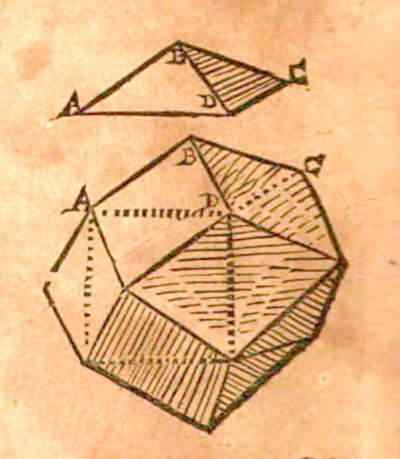- About MAA
- Membership
- MAA Publications
- Periodicals
- Blogs
- MAA Book Series
- MAA Press (an imprint of the AMS)
- MAA Notes
- MAA Reviews
- Mathematical Communication
- Information for Libraries
- Author Resources
- Advertise with MAA
- Meetings
- Competitions
- Programs
- Communities
- MAA Sections
- SIGMAA
- MAA Connect
- Students
- MAA Awards
- Awards Booklets
- Writing Awards
- Teaching Awards
- Service Awards
- Research Awards
- Lecture Awards
- Putnam Competition Individual and Team Winners
- D. E. Shaw Group AMC 8 Awards & Certificates
- Maryam Mirzakhani AMC 10 A Awards & Certificates
- Two Sigma AMC 10 B Awards & Certificates
- Jane Street AMC 12 A Awards & Certificates
- Akamai AMC 12 B Awards & Certificates
- High School Teachers
- News
You are here
Kepler and the Rhombic Dodecahedron
The rhombic dodecahedron is a simple and beautiful polyhedron. It is also easy to place within an historical context since we know its discoverer: German astronomer and mathematician Johannes Kepler (1571–1630). On at least three different occasions, Kepler wrote about this polyhedron, showing readers complementary approaches to understanding it. He saw it at the bottom of bee cells. He examined its relation to the difficult problem of the best way of packing spheres (the Kepler Conjecture). And, he was aware that it shares with the cube the property of tessellating space.

Figure 1. Drawing of a rhombic dodecahedron from Kepler's book
Epitome astronomiae copernicanae [Kepler 1618–1621, ii:461].
The rhombic dodecahedron is thus related to the observation of nature, as well as to certain technical and mathematical questions that are both difficult and fruitful. It is even associated with art—Renaissance artists studying polyhedra nearly discovered the rhombic dodecahedron prior to Kepler’s investigations.
In this article, I explore these different historical ways of making sense of this polyhedron and offer readers (teachers, in particular) student-tested resources that can be used to highlight the beauty of mathematics. These materials range in level of difficulty, from building models of basic polyhedra to carrying out some basic calculations to using derivatives to solve a more challenging optimization problem. The activities can therefore be adapted for use with a variety of student audiences in the classroom or in workshops.
I have found that the interdisciplinary approach of these materials provides an enriching way to study mathematics that appeals to today’s students. In this age of electronic devices that offer powerful opportunities for communicating and modeling mathematical concepts, perhaps we should at the same time not lose sight of the educational value in manual activities such as constructing polyhedra. Certainly, my experience is that students enjoy this kind of hands-on activity and we all appreciate the aesthetic appeal of the finished products.
But there are even more potential benefits. For example, physically manipulating three-dimensional bodies gives us a better understanding of the mathematical properties of these objects. Students discover that mathematics is all around them and they are able to understand how it works. Finally, as students recreate the various directions that Kepler’s thinking followed, they realize that mathematics is not a fixed body of knowledge but rather has always been a science in progress. Please continue reading to join me on the voyage of mathematical appreciation that the rhombic dodecahedron makes possible.
Roberto Cardil (matematicasVisuales), "Kepler and the Rhombic Dodecahedron," Convergence (March 2022), DOI:10.4169/convergence20220319




